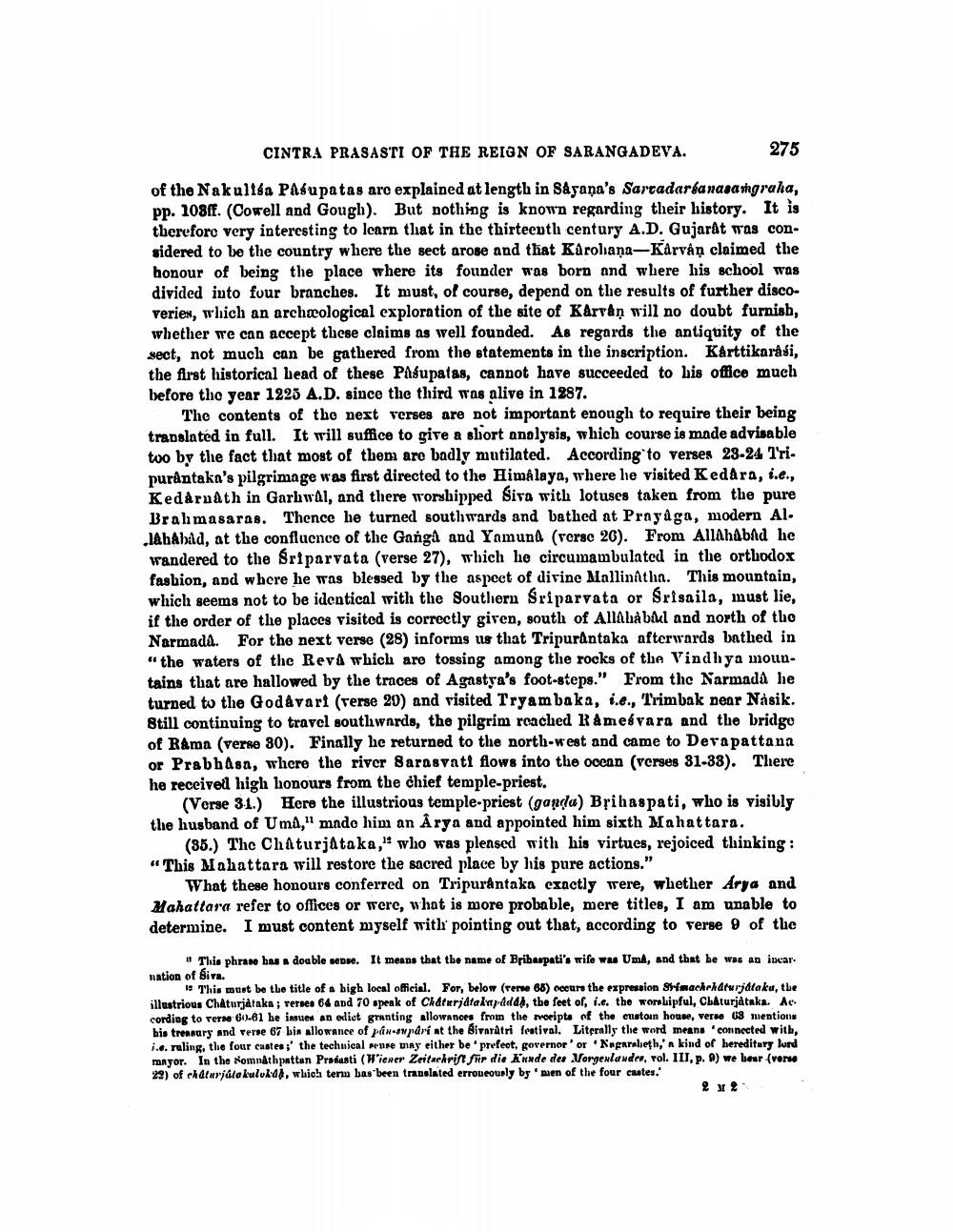________________
CINTRA PRASASTI OF THE REIGN OF SARANGADEVA.
275
of the Nakulisa Pasupatas aro explained at length in Sayana's Sarcadarśanasangraha, pp. 108ff. (Cowell and Gough). But nothing is known regarding their history. It is therefore very interesting to learn tliat in the thirteenth century A.D. Gujarat was considered to be the country where the sect arose and that Karoliana-Karvan claimed the honour of being the place where its founder was born and where his school was divided into four branches. It must, of course, depend on the results of further discoveries, which an archæological exploration of the site of Karvan will no doubt furnish, whether we can accept these claims as well founded. As regards the antiquity of the sect, not much can be gathered from the statements in the inscription. Karttikarasi, the first historical bead of these Pasupatas, cannot have succeeded to his office much before the year 1225 A.D. since the third was alive in 1287.
The contents of the next verses are not important enough to require their being translated in full. It will suffice to give a short analysis, which course is made advisable too by the fact that most of them are badly mutilated. According to verses 23-24 T'ripurantaka's pilgrimage was first directed to the Himalaya, where he visited Kedara, i.e., Kedarnath in Garhwal, and there worshipped Siva with lotuses taken from the pure Brahmasaras. Thence he turned southwards and bathed at Prayaga, modern Al. lahabad, at the confluence of the Ganga and Yamuna (verse 26). From Allahabad he wandered to the Sriparvata (verse 27), which he circumambulated in the orthodox fashion, and where he was blessed by the aspect of divine Mallinathn. This mountain, which seems not to be identical with the Southern Sriparvata or Srisaila, must lie, if the order of the places visitod is correctly given, south of Allahabal and north of the Narmada. For the next verse (28) informs us that Tripurantaka afterwards bathed in * the waters of the RevA which are tossing among the rocks of the Vindhya mountains that are hallowed by the traces of Agastya's foot-steps." From the Narmada he turned to the Godavari (verse 20) and visited Tryambaka, i.e., Trimbak near Nasik. 8till continuing to travel southwards, the pilgrim reached Ramešvara and the bridge of R&ma (verse 80). Finally he returned to the north-west and came to Derapattana or Prabhasa, where the river Sarasvati flows into the ocean (verses 81-33). There he received high honours from the chief temple-priest.
(Verse 31.) Here the illustrious temple-priest (ganda) Brihaspati, who is visibly the husband of Uma," made him an Arya and appointed him sixth Mahattara.
(35.) The Chaturjataka, who was pleased with his virtues, rejoiced thinking : "This Mahattara will restore the sacred place by his pure actions."
What these honours conferred on Tripurantaka exactly were, whether Arya and Mahattara refer to offices or were, what is more probable, mere titles, I am unable to determine. I must content myself with pointing out that, according to verse 9 of the
# This phrase has a double sense. It means that the name of Brihaspati's wife was Umh, and that he was an idear. mation of Biva.
1. This must be the title of a high local official. For, below (Terre 68) occurs the expression Shimachrhdturjdtaka, the illustrious Chaturjátaka ; verses 64 and 70 speak of Chaturjdtalapáda, the feet of, i.e. the worshipful, Cbáturjátaka. Ae. cording to rerne 60.61 be inuen an aliet granting allowances from the moeipta of the onetoin house, verse 08 mentions bis treasury and rerne 67 bir allowance of pan-swpdrí at the divaratri festival. Literally the word means 'connected with, i.e. ruling, the four castes;' the technical sure may either be 'prefect, governor' or 'Kagerabeth,' kind of hereditary lord mayor. In the Romnathpattan Prasasti (Wiener Zeitechrift für die Kunde der Vorgenlander, rol. III, p. 9) we bear (veru 29) of chaturjáte kulud), which tenu bas been translated erroneously by men of the four castes.




